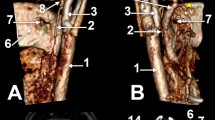Abstract
The aim of this study was to investigate and correlate the anatomical parameters of the superior laryngeal artery (SLA). For the study, 50 adult, human specimens were used; laryngeal pieces were drawn from 16 cadavers and the arteries were dissected intralaryngeally. In 68%, the SLA originated from the superior thyroid artery and in 32%, directly from the external carotid artery. In five sides, an aberrant superior laryngeal artery (ASLA) was entering the larynx through a foramen thyroideum. The normal superior laryngeal artery (NSLA) had a short extralaryngeal part and continued intralaryngeally, with two segments and a point of inflexion; the first segment ran along the superior border of the thyroid cartilage, the point of inflexion of the NSLA was at a minimal distance of 1.1 cm anterior to the superior horn of the thyroid cartilage and from this point the NSLA continued in the paraglottic space. The ASLA had a constant origin from the superior thyroid artery; it then traversed the foramen thyroideum and reached the paraglottic space–at the superior border of the lateral cricoarytenoid muscle, it ended in two terminal branches. We constantly evidenced the following collateral branches of the NSLA: superior, anterior and postero-medial. The terminal branches are the antero-inferior branches that constantly anastomose with the cricothyroid artery and the postero-inferior branch anastomosed with the inferior laryngeal artery. Occasionally, additional branches of the NSLA were found. In conclusion, the intralaryngeal branching patterns of the NSLA and the ASLA are similar, the differences being given by the entry point into the larynx that will make the superior and anterior branches of the ASLA longer, will eliminate the transversal segment of the NSLA, and will shorten the descending segment in the paraglottic space in the case of ASLA. The base of the upper horn of the thyroid cartilage, the oblique line and its tubercles, the cricothyroid membrane and the cricothyroid joint are constant landmarks that allow a precise intralaryngeal identification of the SLA. These findings can improve performances during surgical manipulations of the larynx and laryngeal transplants.







Similar content being viewed by others
References
Anthony JP, Argenta P, Trabulsy PP, Lin RY, Mathes SJ (1996) The arterial anatomy of larynx transplantation: microsurgical revascularization of the larynx. Clin Anat 9(3):155–159
He X, Ye C, Carrat X, Traissac L (1999) Anatomical study of the thyroid foramen in human larynx: a study of 100 dissections. Rev Laryngol Otol Rhinol (Bord) 120(2):127–129
Iimura A, Itoh M, Terayama H, Nakamura Y, He G, Kondo Y, Takahashi T, Shimada K (2004) Anatomical study of meandering and functions of human intralaryngeal artery. Okajimas Folia Anat Jpn 81(5):85–92
Lang J, Nachbaur S, Fischer K, Vogel E (1987) The superior laryngeal nerve and the superior laryngeal artery. Acta Anat (Basel) 130(4):309–318
Liu JL, Liang CY, Xiang T, Wang F, Wang LH, Liu SX, Yang HJ (2006) Aberrant branch of the superior laryngeal artery passing through the thyroid foramen. Clin Anat 20(3):256–259, DOI:10.1002/ca.20396
Ortug C, Gunduz T, Sam B (2005) The incidence of the foramen thyroideum in Turkish population. Surg Radiol Anat 27(6):491–494
Pearson BW (1975) Laryngeal microcirculation and pathways of cancer spread. Laryngoscope 85(4):700–713
Reidenbach MM (1996) The periepiglottic space: topographic relations and histological organisation. J Anat 188:173–182
Sanudo JR, Maranillo E, Leon X, Mirapeix RM, Orus C, Quer M (1999) An anatomical study of anastomoses between the laryngeal nerves. Laryngoscope 109(6):983–987
Tazbir J, Dedecjus M, Kaurzel Z, Lewiński A, Brzeziński J (2005) Selective embolization of thyroid arteries (SETA) as a palliative treatment of inoperable anaplastic thyroid carcinoma (ATC). Neuro Endocrinol Lett 26(4):401–406
Terayama N, Sanada J, Matsui O, Kobayashi S, Kawashima H, Yamashiro M, Takanaka T, Kumano T, Yoshizaki T, Furukawa M (2006) Feeding artery of laryngeal and hypopharyngeal cancers: role of the superior thyroid artery in superselective intraarterial chemotherapy. Cardiovasc Intervent Radiol 29(4):536–543
Trotoux J, Germain MA, Bruneau X (1986) Vascularization of the larynx. Update of classical anatomic data from an anatomical study of 100 subjects. Ann Otolaryngol Chir Cervicofac 103(6):389–397
Williams Pl, Bannister LH, Berry MM, Collins P, Dyson M, Dussek JE, Ferguson MWJ (eds) (1995) Gray’s anatomy, 38th edn. Churchill Livingstone, New York
Author information
Authors and Affiliations
Corresponding author
Rights and permissions
About this article
Cite this article
Rusu, M.C., Nimigean, V., Banu, M.A. et al. The morphology and topography of the superior laryngeal artery. Surg Radiol Anat 29, 653–660 (2007). https://doi.org/10.1007/s00276-007-0267-4
Received:
Accepted:
Published:
Issue Date:
DOI: https://doi.org/10.1007/s00276-007-0267-4




